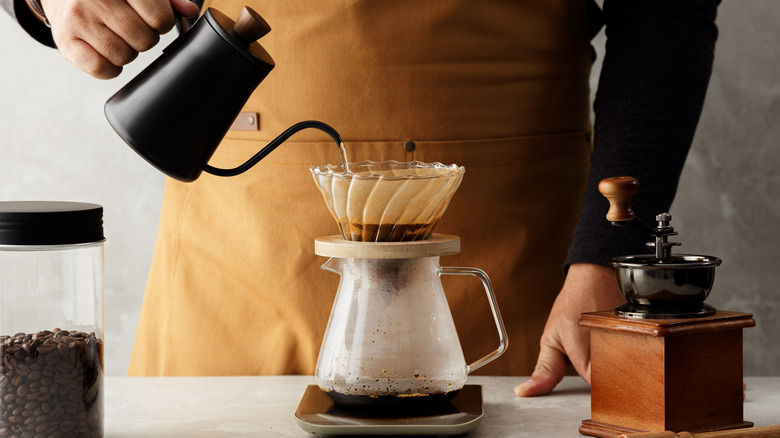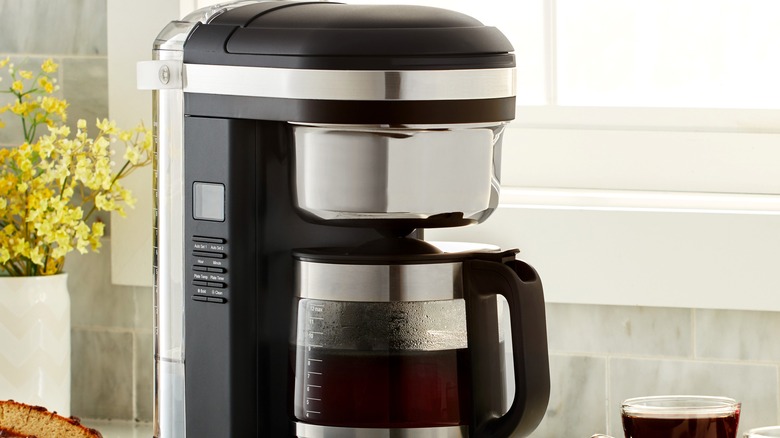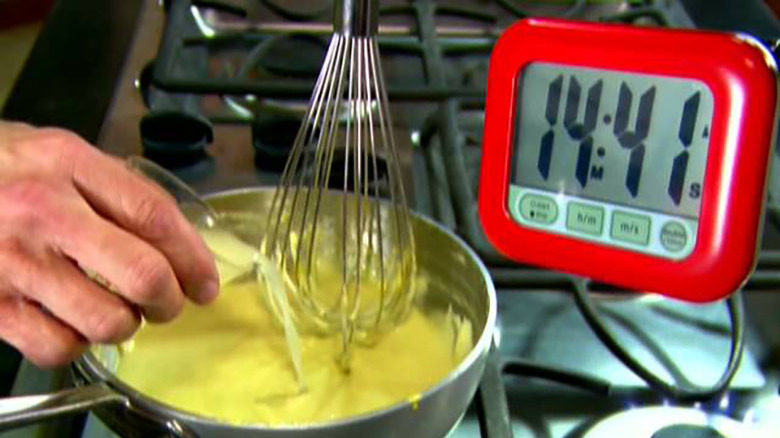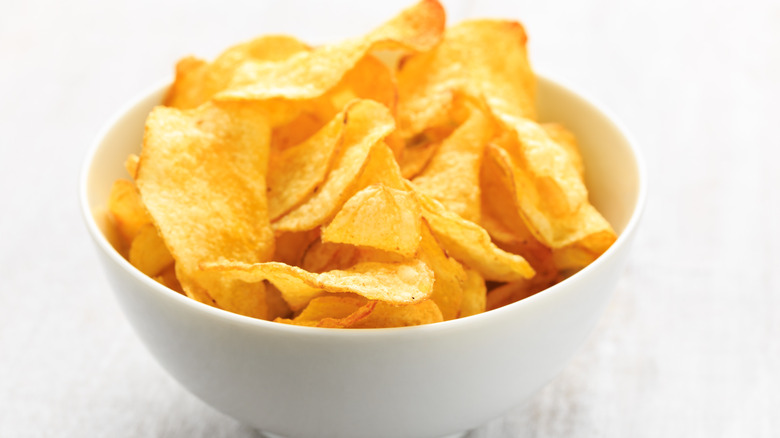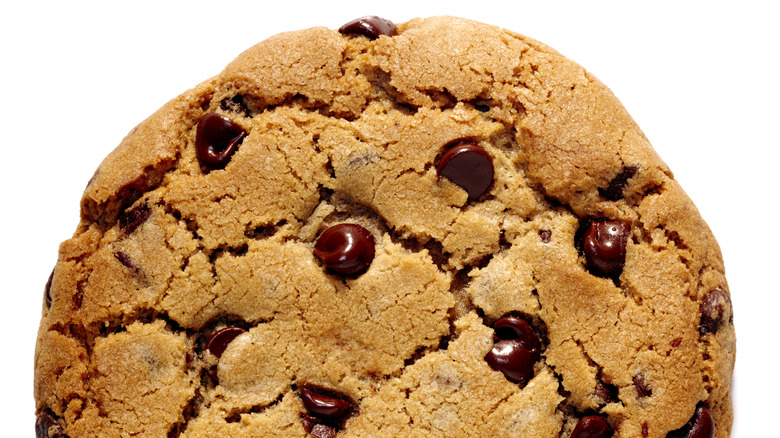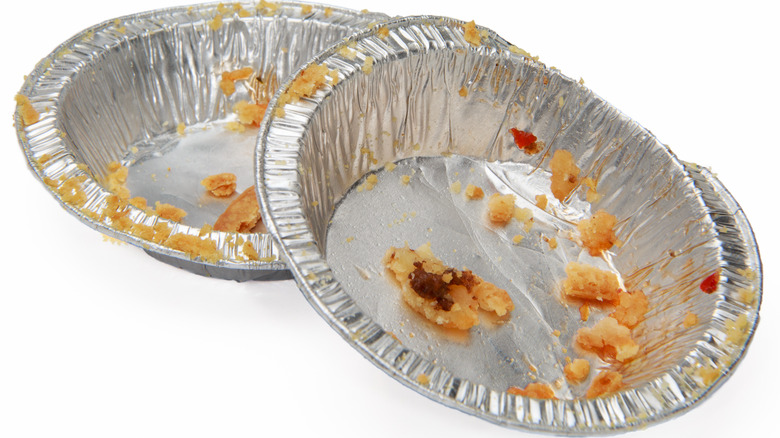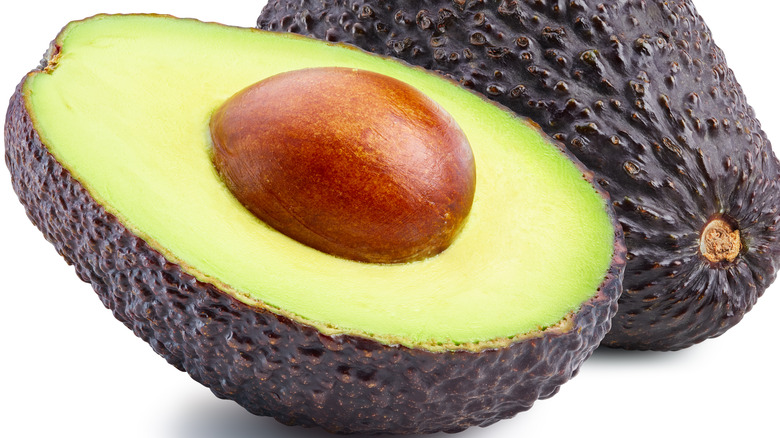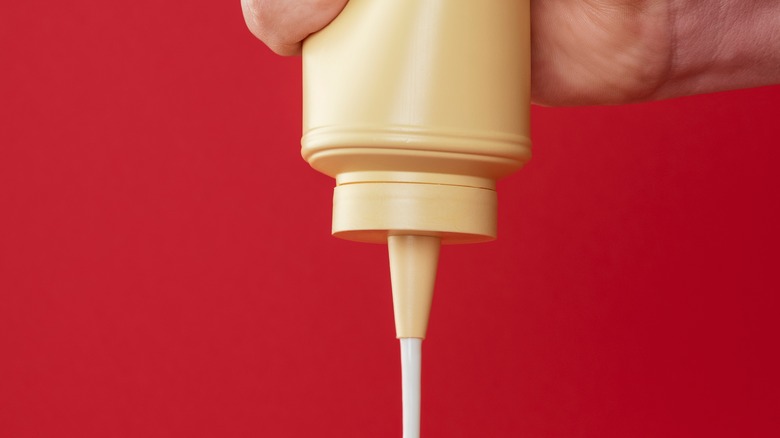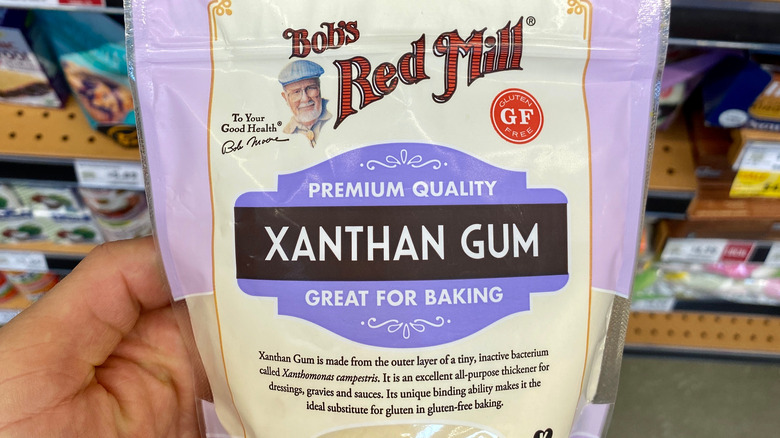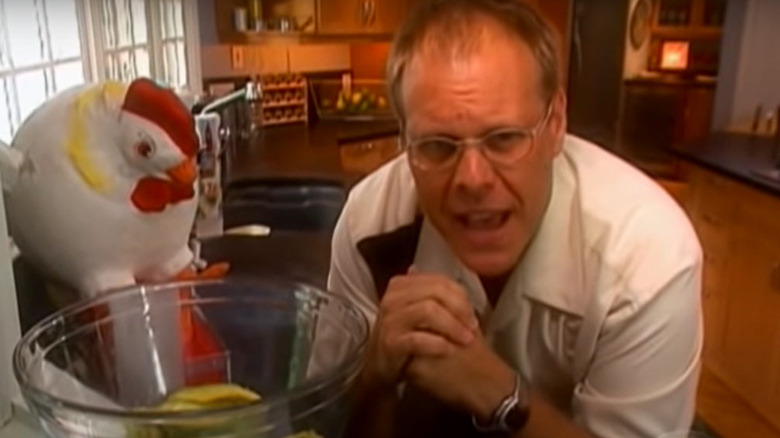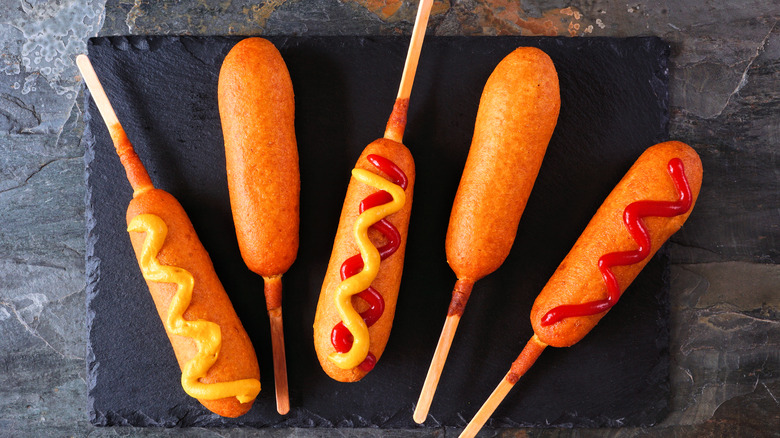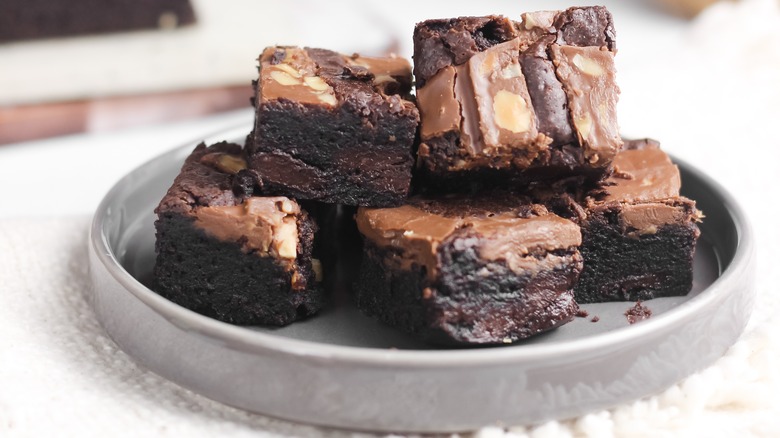Good Eats Hacks You Should Use In Your Own Kitchen
"Good Eats," the popular cooking show on the Food Network, first aired in 1999. Frustrated with the current state of American cooking shows, Alton Brown set out to create something better.
After attending the New England Culinary Institute and graduating in 1997, Brown created "Good Eats." With a focus on the underlying process of cooking, the show was unique in that it combined science, history, and humor, with each episode focusing on a different type of food, dish, or culinary technique. While, after 17 seasons, the final episode of "Good Eats: The Return" aired in July 2021, the host and creator's genius cooking hacks live on.
What's a kitchen hack? A clever shortcut or unconventional method for making food prep easier, cheaper, and faster. Kitchen hacks can be especially helpful for those who don't have a lot of experience cooking but can also help anyone save time and money without having to buy expensive tools or ingredients.
With the right hacks, food is always a little bit better. Happily, past episodes of "Good Eats" offer a treasure trove of options, some of the best of which we've rounded up for you here. Whether you're looking to cook a little faster or turn out a better final product, chances are Alton Brown has got a solution for you.
The salt in your coffee hack
As reported by Southern Living, the "Good Eats" coffee hack involves an unexpected, but common ingredient, sodium chloride. It may seem counterintuitive to add salt to a beverage that is generally prepared sweet, but the common pantry ingredient can actually enhance the flavor of coffee in a number of ways. No, not by turning your favorite morning wake-me-up into a sodium slurry, but actually be enhancing its best qualities. As Alton Brown notes in this hack, adding a pinch of salt to your coffee grounds before brewing can reduce the bitterness of the beverage, making it smoother and more palatable.
Brown suggests that for every six tablespoons of ground coffee beans you brew, to add ¼ teaspoon of salt to the basket. He also notes that while it's enough to subtly enhance your brew's sweet taste, you won't be able pick up on any of the salty flavor.
The leftover coffee hack
Still have a little of that lightly salted pot of Joe left? With a few extra ingredients and some space in the freezer, you can turn those final cups into a refreshing granita. Granita is a semi-frozen dessert made from sugar, water, and various flavorings. Often served as a refreshing summer or after-dinner treat, granita has a coarse, crystalline texture and is related to sorbet and Italian ice.
The practice of making granita is believed to have started in ancient Mesopotamia, when couriers would trek into the mountains to retrieve snow and ice for royal beverages. Eventually, the practice made its way to Sicily. Traditionally, the combination of sugar, water and flavorings were then frozen, scraped with a fork, and served in a glass with a spoon, similar to the version Alton Brown makes in his Season 1, Episode 6 "Good Eats" recipe.
To make this delicious dessert, start with strong coffee, then mix it with sugar and a bit of vanilla extract. Once the mixture is combined, pour it into a shallow pan and place it in the freezer. As it freezes, the mixture should be stirred and scraped every 30 minutes for about three hours, or until it forms a slushy texture. Once it's done, scoop the granita into individual dishes and serve with a dollop of whipped cream or a sprig of mint. This simple yet tasty recipe is a delightfully refreshing way to end a special meal or even just enjoy your favorite beverage on a hot summer day.
The eggs Benny hack
There are so many reasons to love brunch, but no doubt eggs Benedict is at the top of most people's lists. However, when crafting one's own Benedict, there are a few different stages where things can go wrong.
In this "Good Eats" hack, Alton Brown shares a number of tips for turning out the perfect brunch dish. He starts with poaching the eggs, suggesting that you first bring the water to a boil, then use a thermometer to track when it cools down to 205 degrees. After cooking them at that temp for five minutes and then plunging them into an icy bath, Brown notes that "you can refrigerate your eggs in their bath for up to six hours without losing any real quality," thereby allowing you to focus on the other key parts of the process, such as making some rich, creamy hollandaise sauce.
Once the accompanying elements are prepared, Brown suggests you place the cooled eggs into a collapsible veggie steamer and quickly submerge it in a pot of boiling water to reheat them for a minute. With these clever tips perfect for home chefs, you'll be wowing your brunch guests (or even just your own taste buds) in no time.
The salt-and-vinegar chip hack
Salt and vinegar chips have been around since the 19th century, and are still a popular snack food, with many different brands and varieties available. Grab a bag of your favorite crisp variation for this unusual –- and uniquely delicious –- chicken parm recipe, where they feature as the secret ingredient.
Chicken Parmesan is a classic Italian-American dish that is sure to please any crowd, and the "Good Eats" version is no exception. The first step in Alton Brown's recipe is to pound the chicken breasts to an even thickness, so they cook evenly and quickly. Then, the chicken is seasoned with salt and pepper and dredged in a breadcrumb and salt-and-vinegar potato chip mix before being shallow-fried in hot oil. Once golden brown, the chicken is dolloped with marinara sauce and a generous amount of cheese, placed in a preheated oven and broiled until it is hot and bubbly.
While chicken parm can be quite soggy and even insipid, Brown promises that his unique version is quite the opposite, with a pervasively crunchy crust and flavorful sauce making it a dish to remember.
The chewy chocolate chip cookie hack
In this Season 3, Episode 6 "Good Eats" tip, you'll want to sub bread flour for the usual all-purpose variety to achieve chewy, bakery goodness. Bread flour is higher in protein than the all-purpose flour typically used. The higher protein content and gluten development help to create firm structure and a chewy texture.
The chocolate chip cookie recipe starts by creaming together butter, brown sugar, and white sugar until light and fluffy. This helps create a cookie that is slightly crisp. Then, egg, milk, vanilla extract, and baking soda are added and mixed thoroughly. Finally, the dry ingredients are added, and the dough is then scooped out and placed on baking sheets.
"This is essentially a hack of the most famous chocolate chip cookie recipe in the world," Alton Brown explains on his blog, "which we all know from the back of the Nestle 'morsel' bag." Brown goes on to explain that the subsititution of bread flower and addition of milk over an egg white, as well as the brown and white sugar ratio, all contribute to an extra chewy cookie.
The recycled pie pan hack
In this "Good Eats" clip from 2010, Alton Brown teaches us how to make the perfect porterhouse. He starts by dry-aging a steak like the pros using a few everyday items that might otherwise be destined for the trash bin.
With some repurposed pie tins, wooden skewers, and an ice pick, you can achieve top-drawer steakhouse perfection in your own fridge. With this hack, you punch five holes in each side of the aluminum pan and then use them to create a shelf from the skewers. While he doesn't specify, if you're fresh out of skewers, then it's quite likely some leftover chopsticks would do the job just as well.
Once you've created your "steak aging rig," wrap the meat in paper towels and place it in the coldest part of your fridge for 24 hours. Change those ("wet and gooey," warns Brown) paper towels out, then put it back in to chill for three more days, and your steakhouse-worthy hack is complete.
The avocado hack
Native to Central and South America, avocados are known for their creamy texture and mild flavor. Their mild flavor and creamy texture make them a versatile ingredient to experiment with in the kitchen. With your perfect, dry-aged porterhouse now underway, this Alton Brown's "Good Eats" simple compound butter avocado hack results in a super-creamy topping for steak, fish, poultry, corn, or even grilled bread.
The base of the compound butter is not butter at all, but avocado, which is then seasoned with garlic, cilantro, lemon juice, and cumin. This combination of flavors creates a butter that is creamy and slightly tart, with a hint of spice. Begin by mashing the avocado in a medium bowl and adding the other ingredients.
Once the ingredients are combined, use a rubber spatula to mix everything together until it forms a thick paste. Once the mixture is ready, scoop it into a small container and place it in the refrigerator until it is solid and ready for your sizzling steak or other decadent dish.
The mayo hack
While those who aren't big fans of the condiment on its own might (understandably) squirm, it turns out that adding mayonnaise to scrambled eggs results in a creamy, rich variation. This "Good Eats" scrambled eggs hack is a delicious twist on the breakfast classic. This simple and easy recipe calls for just a few ingredients and takes only minutes to prepare. To make it, combine eggs, mayonnaise, and butter in a bowl and whisk until blended. Heat a non-stick skillet to medium-low heat and add the egg mixture. Use a rubber spatula to gently push the eggs around the pan until they form small curds and are cooked through.
This dish is great as a quick and easy breakfast or as a light lunch. The mayonnaise adds a nice flavor to the eggs and helps to keep them moist and fluffy. Try adding some herbs, spices, or cheese to the eggs to give them some extra flavor.
The xanthan gum hack
The surprise ingredient hack that adds a smooth silkiness to this salsa verde? Every gluten-free baker's good friend, xantham gum. Xanthan gum is a safe and natural polysaccharide food additive derived from the outer layer of a bacterium called Xanthomonas campestris. It is used in a variety of commercial and home cooking applications, particularly in many gluten-free recipes as a replacement for gluten, and can be purchased at most health food stores.
As this "Good Eats" recipe shows, xanthan gum can also be used to thicken and stabilize sauces, dressings, and other preparations. It helps to prevent ingredients from separating, which in turn lends a rich and creamy texture. Too much can make a dish overly thick and gummy, so it's generally recommended to use only a small amount at a time and add more if needed.
In addition to the thickener, this salsa verde is made with charred green tomatillos, onions, cilantro, chilies, and salt. All of these ingredients are blended together in a food processor to create a tangy and flavorful sauce which can be used as a dip for chips, as a topping for tacos and burritos, or served over grilled meats or fish.
Not so sure about adding the xanthan gum? As Alton Brown says on his own website, "Don't freak out. This thickening agent is naturally occurring and sticky enough to stabilize emulsions like salad dressing. A pinch will not only thicken our salsa, but also allow more of the fruit flavors of the tomatillo to come through. Cool, huh?" Cool indeed.
The potato masher hack
Alton Brown's guacamole dip recipe is a delicious and flavorful way to enjoy your favorite chips and dip. In this "Good Eats" hack from 2009, Brown explains that chunks are critical to crafting the perfect guacamole. "To really celebrate the avocado you need chunks," Brown claims, "so pureeing is not going to work."
To get the right silky-yet-toothy texture, he suggests you bust out an unexpected, but common kitchen tool: the potato masher. Before you mash, he recommends adding any "granular substances" such as salt, cumin and cayenne pepper. The avocados provide a creamy and smooth texture that is further balanced with the acidity of lime juice and the spicy kick of the jalapenos. Garlic also adds a unique flavor that helps to enhance the other ingredients, while cilantro creates a fresh and vibrant finish to this memorable dip.
A final tip for the perfect guacamole is to let the ingredients sit for a few hours to meld, but note that "cold turns down the volume on flavor." If you've put yours in the fridge to rest, be sure to let it come back up to room temperature again before any further tinkering with the seasonings.
The corn dog hack
Corn dogs first hit the state fair scene in the 1940s, according to MPRNews. They are traditionally made by coating a hot dog with a thick layer of cornmeal batter, then deep-frying it until golden brown and crispy. The combination of the savory dog and the crunchy-on-the-outside, soft-on-the-inside cornmeal batter make for a delicious treat.
Corn dogs are often served on a stick, although in this "Good Eats" hack for the perfect corn dog, Brown offers a unique take. Along with the atypical batter additions of chopped jalapeno, grated onion and can of creamed corn, part of his hack involves the stick. "We don't need no stinking hot dog buns," states Brown. "However, we need sticks: Popsicle sticks, tongue depressors, coffee stirrers, disposable knitting needles, heck, I've tried them all, but i have never found a better corn dog handle than the chopsticks that you get with Chinese takeout. The secret is to leave them connected."
Another element of his corn dog hack involves dipping the hot dog into corn starch before coating it with the batter. Brown notes that it's important to get that layer as thin as possible, lest the corn-dabbled batter slip right off into the fryer. Onions, corn, jalapenos, buttermilk, hot dogs and a deep fat fryer? Yes, please.
The half-baked brownies hack
Alton Brown's cocoa powder-based brownies became a legend soon after appearing in one of the original episodes of the show. The original, for the most part unaltered, recipe is sure to be a hit with anyone who loves chocolate. This recipe calls for a combination of dark and light cocoa powder, as well as butter, sugar, eggs, vanilla extract, and all-purpose flour. The brownies bake up rich and decadent, with a flavor that's distinctly "chocolatey" when compared to box mixes.
However, Brown wasn't about to rest on his laurels, and Season 1, Episode 10 of "Good Eats: Reloaded" served up an improvement on near-perfection. Baking something twice is a great way to ensure that your final product is perfect. In this case, the result is a product that is more moist, flavorful, and evenly cooked. As explained on Alton Brown's own site, the "version 2.0" creates a crust that's still fudgy and perfecly flaky, but is it's own thing compared to the original.
To achieve the perfect gooey center, Alton Brown suggests you take a pause while baking his Brownies: Reloaded in order to achieve the ideal texture. Take a pause, what? Pulling them out of the oven for 15 minutes mid-bake is apparently the little-known texture secret that's now been released into the wild.
With these clever hacks in your repertoire, you'll be well on your way to cooking your own chef-worthy creations. Bon appetit!

